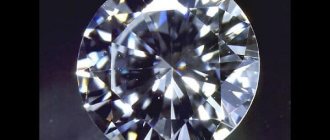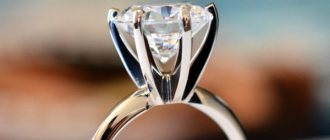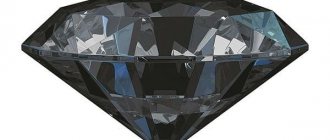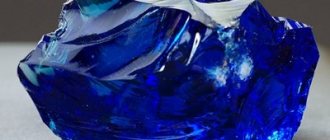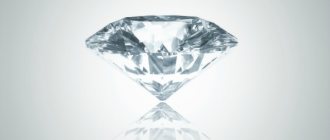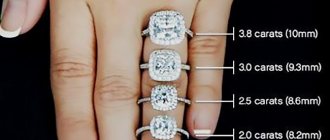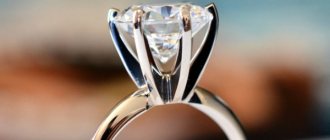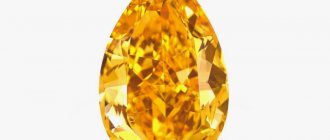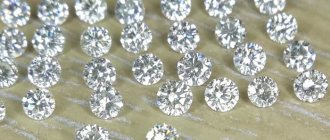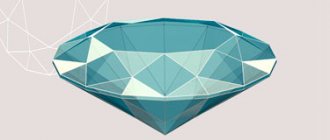- Common rating systems
- Diamond Color Grading
- Determining Diamond Clarity
- Determining the carat value of diamonds
- The influence of cut quality on the cost of a diamond
- How to determine the value of a diamond using an online calculator
With its bright spectrum of colors, skillful cutting, enchanting beauty and passion, brilliant has remained a desired decoration for many for hundreds of years. But how to determine the value of a diamond - such an expensive and amazing stone? The so-called 4 C rule will help answer this question. Its name is derived from four English words: caratweight (weight), color (color), clarity (purity) and cut (cut). The price of a diamond depends on these parameters. A stone that is larger in size, more transparent, cleaner and better cut will cost more. At the same time, different countries have their own assessment systems.
Bracelet with diamonds 1.76 kt. 585 gold
135,000 a
Brooch with diamonds 1.88 k. Gold 750. France
Necklace with diamonds 1.96 kt. 750 gold.
When purchasing a diamond, it is recommended to use the 4 “C” rule - an abbreviation of the words caratweight (weight), color (color), clarity (purity) and cut (cut).
The first indicator is considered the main one (1 carat = 0.2 g) and the carat of diamonds is directly related to the cost. Stones weighing up to 6 carats are found on open sale.
The color of a perfect diamond is colorless and when placed in H2O it becomes invisible. Perfect stones are few, rare and expensive. In nature you can find yellowish, bluish and, increasingly attractive, black diamonds.
The existing grade of diamond clarity has 12 scales, where the 1st includes flawless diamonds, the last - “dirty”. But only from the ninth group can defects be visually detected.
Giving a special configuration - a diamond cut - is designed to bring out the natural sparkle of the stone. The classic cut consists of 56 facets. Their shape resembles the fusion of 2 pyramids, one of which (the upper one) is truncated. The art of cutting is to ensure that light falling on a surface achieves total internal reflection.
With its bright spectrum of colors, skillful cutting, enchanting beauty and passion, brilliant has remained a desired decoration for many for hundreds of years.
Common rating systems:
- For several hundred years, the calculation of the value of diamonds has been based on Tavernier's rule: m (carat)2 x base value of a 1 carat diamond = total value. That is, to determine the price of a diamond, you need to square its weight in carats and multiply by the cost of one carat. Since the weight is squared, the cost of diamonds of 2 carats, 3 or 4 carats will differ significantly. For example, a three-carat diamond will cost almost ten times more than a one-carat diamond. But this rule only works for diamonds weighing up to five carats, since larger stones are considered especially rare and are valued individually. And the rarest diamonds even receive individual names: “Cullinan” (3106 carats), “Excelsior” (995 carats), “Star of Sierra Leone” (969 carats).
- The Rapaport reference table system is a world-wide, authoritative system for estimating the value of diamonds (calculation basis: 4C-carat+1 color). It is released and updated every week, and gives the opportunity to adjust prices to all persons interested in transactions. In Russia, control over price lists is exercised by Gokhran, formed in 1920, and today part of the Ministry of Finance. But for him, the starting point is the above tables.
- Four diamond grading systems are recognized by the international community and are used: GIA – in America; IDC or HRD – in Belgium; Scan DN – Scandinavian Nomenclature; CIBJO – International Confederation of Jewellery, Pearls and Silver.
- In the Russian Federation, the classification of diamonds is shown in Technical Conditions (TU) 117-4.2099-2002 “Diamonds. Technical requirements. Classification" is the most complex of the evaluation taxonomies.
The prices shown in the newsletter, although basic, are not a verdict on the flexible gemstone market.
Prices are shown in US currency. The renewal of tabloids comes with its own nuances. The cost of classic round stones changes weekly, and with an original cut – monthly. How to work with tables? Let's look at it with an example. Imagine a chessboard, where each piece corresponds to the value of the intersection of the horizontal and vertical lines. The vertical lines in the table contain the letter designation of the color characteristics of the stone, the horizontal lines indicate the purity of the diamond.
We select the second table, horizontally VS1, vertically – F. The intersection gives the number 92. Multiply the value by 100 and the mass of the stone. As a result, we get the cost of the stone in dollars. Please note that the tables (there are 14 in total) are divided by carat, so the values fluctuate.
Diamond Color Grading
Bracelet with diamonds 7.04 kt. 585 white gold.
Brooch with sapphires and diamonds. 585 gold.
Ring Rubies, diamonds. Platinum 950
The color and clarity of a diamond depend solely on nature. The Russian color calculation method divides artificially cut diamonds into three large classes with individual criteria. For example, for the KR-17 type (small round diamonds with 17 facets), there are four breakdowns into classes from colorless to brown.
Round diamonds with 57 facets (KR-57) are divided into 7 color grades, and for larger ones - into 9. Colorless, white, bluish, reddish, dark gray, brownish and black diamonds are found in nature. More often the color is distributed unevenly.
There is a table of clarity and color of diamonds, but only a highly qualified practitioner, using special methods, is able to distinguish up to a thousand varieties of filigree diamonds, color nuances, microcracks and inclusions.
The Russian system presents the following color characteristics of diamonds:
| Color group | Characteristic |
| 1 | Perfect, without color, with a hint of blue |
| 2 | Colorless |
| 3 | With a subtle tint |
| 4 | With a slight yellowish tint |
| 5 | With perceptible shades of yellow, green, purple, gray, as well as a slight touch of brown |
| 6 | With highly visible yellow, green, aqua and gray tones |
| 6-1 | With a visible brown tint |
| 7 | With clearly visible yellow, green, lemon, aquamarine and gray tints |
| 8-1 | Subtly colored yellow |
| 8-2 | Lightly colored yellow |
| 8-3 | Lightly colored yellow |
| 8-4 | Light yellow |
| 8-5 | Yellow |
| 9-1 | Lightly colored brown |
| 9-2 | Lightly colored brown |
| 9-3 | brown |
| 9-4 | Dark brown |
In international practice, the color characteristics of diamonds are divided according to slightly different criteria (Table 2):
Comparative table of the two systems (Table 3):
Color has such an impact on the price of a diamond: the clearer the stone, the more you can get for it. And with increasing transparency, the price of a diamond increases exponentially, although most often the difference in the smallest tones of stones can only be noticed by a specialist using equipment.
Rapaport scale
For a comprehensive assessment of the cost of a diamond, we offer you, in addition to our Diamondomer service, to use the data from Rapaport’s price list. This price list is regularly published by the Gemological Institute of America (GIA), the most respected and authoritative scientific gemological institution in the world. The Rapaport scale is updated every two weeks. We provide you with the latest official information published on the Internet. You can download it below. Later versions of the Rapaport scale are quite difficult to find in the free public domain; they can only be purchased, for example, here.
Who is Rapaport?
In 1978, the first issue of the now world-famous Rapaport price list was published. It was named after its creator Martin Rapaport. He is a renowned expert on the diamond market. He entered the family business and almost immediately realized that the market could not exist without a single summary sheet of information on world prices for diamonds. At first his idea was received with caution and even indignation, but now it is used all over the world.
Of course, this scale is not perfect, it has many shortcomings, and the market is very flexible, but nevertheless, it is used by the majority of diamond sellers around the world.
How to use the Rapoport scale
What is shown in the table?
Rapaport's price list reflects the average retail price of diamonds in the New York market. This price list is based on an analysis of the consumption and supply of diamonds to the diamond market, on statistics, in general, on bare facts. Of course, the Rapaport scale is not a mandatory requirement for jewelry stores and showrooms, but only summarizes average market trends.
As can be seen from the tables that can be downloaded below, the rise in prices for diamonds is not at all proportional to their weight. Roughly speaking, the larger the diamond and the better its characteristics, the higher the price per carat.
Determining Diamond Clarity
Proponents of the GIA rely on a diamond clarity chart to grade diamonds based on how visible flaws are upon visual inspection.
| Letter name | Group | Cleanliness characteristics |
| FL | absolutely no inclusions | |
| IF | INTERNALLY FLAWLESS | do not have internal inclusions, microdefects and microcracks are acceptable |
| VVS | VERY, VERY SMALL INCLUSIONS | tiny inclusions, barely visible to professionals when using 10x magnification |
| VS | VERY SMALL INCLUSIONS | small formations visible under 10x magnification |
| S.I. | SMALL INCLUSIONS | inclusions visible under 10x magnification |
| I | IMPERFECT | inclusions visible to the naked eye |
To determine the purity of a stone in Russia, a more in-depth inspection is used. There are several groups of defects, with certain types of defects.
Taken into account:
- defect size;
- quantity;
- reason for appearance;
- location.
In the public domain you can see the table for the clarity of a diamond, but only we have the criterion “the level of transparency of the lower edges through the upper ones,” which is understandable only to a professional. In addition, for minerals of different sizes with an unequal number of faces, their own rating system is used. The relationship between the clarity characteristics of diamonds according to specifications and the GIA system is shown in Table 5.
| Characteristics of purity groups | Diamond Clarity Group | ||
| Kr-17 Kr-33 | Kr-57 | ||
| Up to 0.29 ct | Over 0.30 ct | ||
| Perfect, no defects | 1 | 1 | 1 |
| in the central zone a light dot is visible, in the middle and peripheral zones there are no more than 2 subtle light dots or one subtle stripe | 2 | 2 | 2 |
| Having defects: in the central zone no more than three minor light spots or in the middle and peripheral zones no more than two defects in the form of minor dark spots or stripes | 3 | 3 | |
| Having defects: in the central zone no more than two small dark spots, or in any zone no more than four small light spots, or no more than two stripes, or one strip and three small light spots, or in the peripheral zone one minor crack | 4 | ||
| Having defects: in the central zone there is one small light cloud or one small crack, or no more than six defects in the form of small light stripes; or in the middle and peripheral zones no more than three minor cracks | 3 | 4 | 5 |
| Having defects in any zones: no more than eight small scattered light defects in the form of dots, stripes, small cracks, bubbles, microseams and growth lines, or up to five small dark dots, or one minor graphite inclusion | 5 | 6 | |
| Having defects in any zones: no more than eight small scattered defects (including those faintly visible to the naked eye) in the form of dots, stripes, small cracks, dust clouds or one small graphite inclusion | 7 | ||
| Having numerous defects: in any zones no more than two small graphite inclusions or no more than two small cracks, or one small cloud in combination with a graphite inclusion, or one small crack in combination with a graphite inclusion, or several small cracks in combination with a graphite inclusion | 7a | ||
| Having numerous defects: in any areas except graphite inclusions, including in the form of cracks visible to the naked eye | 4 | 6 | 8 |
| Having numerous defects: in any zones in the form of graphite inclusions, or graphite inclusions in combination with cracks visible to the naked eye | 9 | ||
| Having defects: in any areas of various types, visible to the naked eye, and transparent to view at least 60% of the diamond pavilion facets | 7 | 10 | |
| Having defects: in any zones of various types, visible to the naked eye, and less than 60% of the diamond pavilion facets are transparent for viewing | 5 | 8 | 11 |
| Picked | 6 | 9 | 12 |
The cost of one carat of a diamond will be higher, the fewer inclusions the gemstone contains and the smaller these inclusions. For example, if a diamond weighing one carat is made more pure, then with each level of clarity it will become more expensive by about a thousand dollars. But as you approach the highest purity groups, the price difference begins to decrease. Diamonds with different locations of inclusions can also have different prices. Thus, a stone with inclusions on the edges and back looks better than with central inclusions, and therefore is valued more expensive.
Idex Online Price Index
| No. | Driver | % of Market | Current Avg.Asking Price pc | Index | % of Change | |
| 1 | Round, 4/4 (1.00-1.49), DK, IF-I1 | 12.06% | $5,039 | 102.15 | 0.04% | ↑ |
| 2 | Round, 2.00 (2.00-2.49), DK, IF-SI3 | 8.18% | $9,968 | 113.87 | -0.03% | ↓ |
| 3 | Round, 1.50 (1.50-1.99), DK, IF-SI2 | 7.00% | $6,378 | 104.31 | 0.03% | ↑ |
| 4 | Princess, 4/4 (1.00-1.49), DI, VVS1-SI2 | 2.87% | $3,839 | 95.73 | 0.44% | ↑ |
| 5 | Round, 3.00 (3.00-3.49), DJ, IF-SI2 | 2.71% | $17,272 | 138.20 | -0.08% | ↓ |
| 6 | Round, 3/4 (0.70-0.89), DH, VVS2-SI2 | 2.04% | $2,974 | 88.40 | 0.04% | ↑ |
| 7 | Round, 1/2+ (0.50-0.69), DG, VVS2-SI1 | 1.71% | $2,561 | 87.03 | 0.01% | ↑ |
| 8 | Princess, 2.00 (2.00-2.49), EI, VVS2-SI1 | 1.70% | $7,213 | 106.23 | 0.00% | |
| 9 | Princess, 1.50 (1.50-1.99), EI, VVS2-SI2 | 1.36% | $5,363 | 105.09 | 0.03% | ↑ |
| 10 | Round, 0.90 (0.90-0.99), DH, VS1-SI2 | 1.00% | $3,482 | 92.06 | 0.11% | ↑ |
| 11 | Emerald, 4/4 (1.00-1.49), EG, VVS2-SI1 | 0.84% | $4,033 | 97.48 | -0.48% | ↓ |
| 12 | Round, 5.00 (5.00-5.99), DJ, IF-SI2 | 0.74% | $36,128 | 192.58 | 0.00% | |
| 13 | Emerald, 5.00 (5.00-5.99), DJ, IF-VS1 | 0.61% | $34,624 | 220.05 | 0.00% | |
| 14 | Radiant, 4/4 (1.00-1.49), EG, VS1-VS2 | 0.38% | $3,909 | 96.36 | -0.23% | ↓ |
| 15 | Round, 4.00 (4.00-4.99), DI, IF-SI1 | 0.32% | $49,361 | 213.26 | -0.01% | ↓ |
Author: Yulia Ozerova, Tatyana Sidorova Publication date: 08/03/2008 Update date: 11/03/2017 Reprinting without an active link is prohibited
You can attach pictures to your review.
Source
In Russia, in new Moscow, there is a unique place where real miracles happen. Here, in one of the technological institutes, diamonds are grown under the supervision of scientists. Usually nature takes billions of years to create these precious stones, and very rarely truly valuable stones are obtained, without many impurities, with excellent characteristics. Over billions of years, many factors interfere with the process and spoil the final result. But people have learned to grow perfect diamonds in laboratory conditions. And today you will learn how this magical process happens.
Diamonds are the strongest materials in nature. They can be preserved for as long as desired without being destroyed. This means that diamonds can be used in the production of various microcircuits, and grandma's diamond (cut diamond) ring will sparkle as brightly as when she was young, even after several generations.
By the way, why do diamonds attract so much attention with their brilliance? Among minerals, this stone has the highest refractive index of light, which is why it is able to shimmer in all colors.
How are diamonds grown? The farm uses the HPHT (high-pressurehigh-temperature) method. This is a development of Russian scientists, which is recognized throughout the world. In nature, diamonds are formed when magma solidifies at a depth of 100 to 200 kilometers. The HPHT method simply imitates the natural process, but significantly speeds it up. To grow diamonds, the temperature in special containers is maintained at approximately 1,500 degrees Celsius. In addition, the process takes place under high pressure of 50-70 thousand atmospheres.
A molten metal alloy, which usually consists of iron, nickel, cobalt and other metals, and graphite is placed inside the container. A substrate with small diamond crystals – a seed – is placed in the container. Next, an electric current is passed through the chamber, in which the metal serves as a catalyst for the crystallization of carbon on the seed - this is how precious stones grow. On the farm, one large diamond or several small ones grow in 12-13 days. Where to buy CVD or HPHT diamonds? The easiest thing is to choose the stones you like on the website https://hp-ht.ru/ in the catalog and order their delivery. The company sells HPHT diamonds directly from the manufacturer. Therefore, the catalog presents the best prices that cannot be found in other stores.
HPHT diamonds are suitable for jewelers. Stones grown using this method have high characteristics. It is possible to synthesize a diamond of any purity and color at the customer's request. Characteristics can also be varied. For example, some jewelers prefer HPHT diamonds with medium characteristics, which are in commercial demand. But it is also possible to grow ideal HPHT diamonds, which jewelers use to create exclusive collections.
Thanks to their amazing characteristics, HPHT diamonds are confidently conquering international markets. Experts have calculated that by 2035 the volume of production of synthetic diamonds will be equal to the volume of production of natural stones.
Source
Determining the carat value of diamonds
A single measure of the weight of diamonds is carat weight
), equal to 0.2 g. The term comes from the seeds of the carob tree (
Ceratonia siliqua
), characterized by its constant mass. Due to their amazing property of preserving mass, they have been used to control the measure of weight since biblical times.
Small diamonds include diamonds up to 0.29 carats, medium ones - from 0.3 to 0.99 carats, and large ones - more than 1 carat. Diamonds over 6 carats are offered for closed auction only.
How to determine the carat value of a diamond? To do this, you can use carat scales that can measure the accuracy of a stone down to thousandths of a carat. Another method is based on the diameter of the stone. If you know the size of the diamond in millimeters, then you can use it to determine the weight in carats (table below). But this calculation will be conditional, since it is quite difficult to accurately calculate the diameter of a non-ideal cut diamond.
Table 6. Carat content of diamonds.
Other techniques to determine which diamonds are better
The Gemological Institute of America (GIA) has developed a system for determining the quality of precious stones (any kind, not just diamonds). In accordance with it, stones are divided into five categories:
- poor (poor quality)
- fair (satisfactory)
- good (good),
- very good (very good) and
- excellent (excellent quality)
Russian jewelry practice uses a slightly different approach. According to it, diamonds are graded into grades A (excellent quality), B (good) and B (satisfactory).
But there is also the American Gemological Society (AGS) with a much more detailed approach to evaluating stones. Standard quality parameters are detailed down to constituent elements such as proportions, polish quality and edge symmetry. The grades given for each of them range from 0 (ideal quality) to 10. Thus, the ideal diamond will be labeled AGS000 (triple excellent).
The influence of cut quality on the cost of a diamond
A diamond cut with a special “brilliant edge” turns into a diamond. It is skillful processing that allows you to reveal the inner strength of the stone, its multi-colored radiance and makes it possible to see incredible spectral metamorphoses. The ideal round cut of the stone is generally recognized. The standard is diluted by a fancy cut (any other shape). However, there is no single rigid system, since shaping depends on the original diamond, its shape, and changing market demand.
The nature of cutting is different and it is impossible to select the best one, because taste preferences are different and what appeals to one will leave another indifferent. However, it has been observed that diamonds with poor cut quality are cheaper. At the same time, there is no significant difference in price between high-quality and very high-quality cuts. The quality of the cut is not indicated in the price lists, but the seller, at his discretion, can charge a higher price for a diamond with an excellent cut.
What else determines the price of diamonds?
It is no secret that in the process of “the race for profitability,” corporations are trying by all means to increase their margins. Diamond giants are no exception. But it is impossible to make an already perfectly cut diamond even better and cleaner. This means that all that remains is to use other marketing tools. The main one is branding. The brand guarantees that “its” stones will be of the best quality, and the very name of the manufacturer seems to speak about this. After all, an ordinary buyer cannot always independently evaluate a stone according to the 4C parameters, and it is often easier for him to rely on a well-known name. For example, retailer Blue Nile markets its Signature Diamonds as being among the “Top 1% of Diamonds in the World.”
To further differentiate themselves from competitors, well-known brands make claims about guarantees of the “pure” origin of diamonds, compliance with ethical principles within their production, the ability to trace the history of each stone, and so on. However, it cannot be said that such instruments currently have an impact on today’s Russian market and its customers.
JEWELERY STONES - CATALOG | DIAMONDS (DIAMONDS) - CATALOG
Origin of diamonds in nature | Chemical composition of diamond | Diamond crystal structure | Diamond size and weight | Physical properties of diamonds | What color is the diamond? | Black diamonds and jewelry with them | Diamond counterfeiting methods | The largest diamonds - complete list | Diamond Golden Jubilee | Cullinan Diamonds from the World's Largest Diamond
Share this article with your friends
Works by designers from the JEWELIRUM catalog
- Co.Cos Jewelry
- Co.Cos Jewelry
- Taiga Jewelry, Tomsk
- Taiga Jewelry, Tomsk
- Ilya Maksimov, Crimea
- Ilya Maksimov, Crimea
- UBIRING
- UBIRING
- Diamonds are Forever
- Diamonds are Forever
- Rings in natural style, Sergacheva Jewelery
- Earrings with pearls, Sergacheva Jewelery
- Cabochon ring, Minty Sky
- Fly earrings, Minty Sky
- Ring, Precious Park
- Ring, Precious Park
- Snake skin ring, Stoyanova Jewelery
- Chain earrings, Stoyanova Jewelery
- Children's pendant - stick, Matthew&Daniel
- Pendant for a child, Matthew&Daniel
- Bracelet, Svetlana Subbotina
- Ring with Slavic symbols, Svetlana Subbotina
- Indian style ring, Anna Goffman
- Indian style ring, Anna Goffman
- Earrings, ISTA
- Geometric ring, ISTA
- Earrings with enamel, PNJewelry
- Ring with enamel, PNJewelry
- Ring, Khramtsova Jewelry
- Ring, Khramtsova Jewelry
- Wedding rings to order, obruchalki.com
- Wedding rings to order, obruchalki.com
- Earrings, Yuri Bylkov
- Earrings, Yuri Bylkov
- Titanium bracelets, LanaMuransky
- Titanium pendant, LanaMuransky
- Brooch Elephant (after Salvador Dali), THING
- Ring Veil, THING
- Mace earrings, VLADIMIR MARKIN
- Cufflinks, jewelry mechanics, VLADIMIR MARKIN
- Drop-shaped ring, EKATERINA TOLSTAYA
- Drop-shaped earrings, EKATERINA TOLSTAYA
- Necklace with amber, LETA
- Earrings with amber, LETA
- Children's earrings, combinable, FASHBY
- Children's earrings, combinable, FASHBY
- Ring of architectural form, Elizaveta Malafeevskaya MANU_L
- Architectural bracelet, Elizaveta Malafeevskaya MANU_L
- Set Ginkgo Leaf, SHABUT JEWELLERY
- Brooch Wearable porcelain, SHABUT JEWELLERY
- Architectural ring, GEOMETRY
- Brooch, porcelain, GEOMETRY
- Necklace made of polymer clay, LICORNE ART
- Brooch made of polymer clay, LICORNE ART
- Ring, avant-garde, VALERY SEREDIN
- Bracelet, avant-garde. VALERY SEREDIN
- Wooden set, Scandinavian/Japanese minimalism, VLADIMIR SHESTAKOV
- Ring, Scandinavian/Japanese minimalism, VLADIMIR SHESTAKOV
- Earrings, TON ANT
- Ring, TON ANT
- Architectural ring, ANCHOR
- Architectural necklace, ANCHOR
- Earrings, GOHFELD JEWELLERY
- Necklace, GOHFELD JEWELLERY
- Massive ring, YAKISCHIK
- Designer jewelry, YAKISCHIK
- Architectural ring, ONE DAY ART
- Architectural ring, ONE DAY ART
- Brooch, bionics, VALERIYA MARKOVA (TESSA)
- Unclosed ring, bionics, VALERIYA MARKOVA (TESSA)
- Ring, bionics, BEAVERS
- Earrings, bionics, BEAVERS
- Earrings, asymmetry, VAGANOVA JEWELRY
- Airplane ring, VAGANOVA JEWELRY
- Flower ring, ALCHEMIA JEWELLERY
- Set, ALCHEMIA JEWELLERY
- Pendant-cat, ethnic, STUDIO OF ILYA AND VERA PALKIN
- Earrings, STUDIO OF ILYA AND VERA PALKIN
How to determine the value of a diamond using an online calculator
Since the price of a diamond depends on several parameters, you can find out its approximate value using special online calculators. In them you need to choose the shape, color, clarity, size of the diamond in carats and grading system. Some models of online calculators use additional calculation parameters. For example, the quality of the cut, which can vary from “satisfactory” to “excellent”.
Affects the cost and availability of the certificate. It is a document that indicates all the physical parameters of a diamond, from diameter to a map of the location of inclusions. If a diamond weighs less than 1 carat, a store certificate is suitable for it, but for large stones it is important to have a certificate recognized by the international community. In particular, the American GIA certificate has the best reputation and significantly influences the price of a diamond. With it, you can offer a diamond on any market without having to prove the properties of the stone every time.
Another characteristic is fluorescence. It appears as a blue glow under the influence of ultraviolet light. Since diamonds without this effect are rarer, they are more expensive.
When calculating the cost of diamonds in an online calculator, do not forget that the figure is conditional. For this reason, some calculators do not indicate a specific value, but a range of possible prices. But using the calculator you can easily track the dynamics of prices for diamonds with different parameters. For example, make sure that the price of a 1-carat diamond differs from the price of a 0.1-carat diamond by no means ten times.
Is it possible to say exactly how much a diamond is worth? In the absence of a certificate, it is not so easy to determine this yourself. Without experience in assessing all the nuances of a particular stone, it will be possible to determine the price of a diamond only approximately. At the same time, the expert will examine the gemstone using special equipment and will give a more accurate estimate of its value.
How rare is your diamond?
All precious stones can be divided into two groups:
- “exclusive” - which includes the most rare and unique specimens, discovered no more than several times a year. For example, some Burmese rubies from 3 carats and above, red diamonds, Ceylon sapphires from 10 carats or excellent quality emeralds
- “ordinary stones” - the main large group with ordinary stones
It is not difficult to guess that representatives of the first group of stones automatically fall into the premium price category, and it makes no sense to approach them with general evaluation rules. Well, the developed rules for assessing the quality and cost of diamonds apply to the main group of more or less ordinary stones, which we will discuss below.
